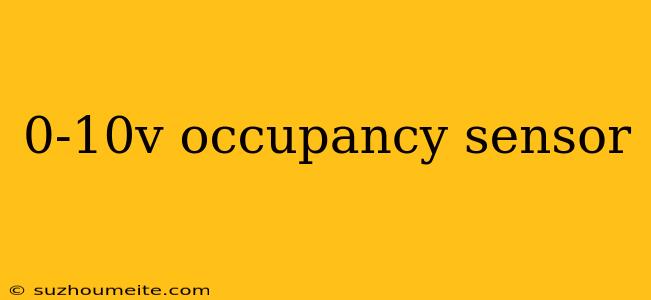0-10V Occupancy Sensor: Understanding the Technology and Its Applications
Introduction
Occupancy sensors have become an essential component in modern building automation systems, enabling efficient energy management and comfort optimization. Among the various types of occupancy sensors, 0-10V occupancy sensors are widely used in commercial and industrial settings. In this article, we will delve into the technology behind 0-10V occupancy sensors, their applications, and benefits.
What is a 0-10V Occupancy Sensor?
A 0-10V occupancy sensor is a type of sensor that detects the presence or absence of people in a given area and outputs a signal in the range of 0-10V DC. This signal is then used to control lighting, HVAC, and other building systems. The sensor typically uses infrared, ultrasonic, or passive infrared technology to detect motion and occupancy.
How Does it Work?
The 0-10V occupancy sensor operates on a simple principle: when an occupant is detected, the sensor outputs a high signal (typically 10V), and when the area is vacant, the signal drops to 0V or a low level (usually around 1V). This analog signal is then fed into a controller or building management system (BMS), which uses it to control the lighting, HVAC, and other systems.
Applications of 0-10V Occupancy Sensors
0-10V occupancy sensors have a wide range of applications, including:
Lighting Control
Occupancy sensors can be used to control lighting in offices, classrooms, corridors, and other areas. When an occupant is detected, the lights turn on, and when the area is vacant, the lights turn off or dim.
HVAC Control
Occupancy sensors can be integrated with HVAC systems to optimize energy consumption. When an area is occupied, the HVAC system adjusts the temperature and airflow to ensure comfort, and when the area is vacant, the system reduces energy consumption.
Security and Access Control
Occupancy sensors can be used to enhance security by detecting presence or absence in sensitive areas, such as data centers, server rooms, or restricted access areas.
Energy Efficiency
By detecting occupancy, 0-10V occupancy sensors can help optimize energy consumption in buildings, reducing energy waste and minimizing the carbon footprint.
Benefits of 0-10V Occupancy Sensors
The benefits of 0-10V occupancy sensors include:
Energy Savings
Occupancy sensors can help reduce energy consumption by up to 30% in commercial buildings.
Increased Comfort
Occupancy sensors ensure that lighting and HVAC systems provide optimal comfort levels when an area is occupied.
Improved Security
Occupancy sensors can enhance security by detecting presence or absence in sensitive areas.
Easy Integration
0-10V occupancy sensors can be easily integrated with existing building management systems and controllers.
Conclusion
In conclusion, 0-10V occupancy sensors are a versatile and widely used technology in building automation systems. Their ability to detect occupancy and output a signal in the range of 0-10V DC makes them ideal for controlling lighting, HVAC, and other building systems. By understanding the technology and applications of 0-10V occupancy sensors, building owners and facility managers can optimize energy efficiency, comfort, and security in their buildings.
